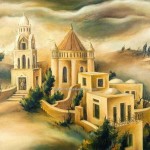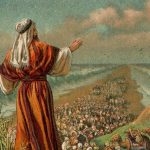
The Story of the Golden Calf
The story of the golden calf, the greatest scandal of the wilderness period, is recalled in Deuteronomy 9:9‑21, based on the fuller account in Exodus 32.
What the calf represented is debated by scholars. Images of bulls and calves were common in Near Eastern religions. In Egypt, a bull, Apis, was sacred to the god Ptah and emblematic of him. In Canaanite literature, the chief god El is sometimes called a bull, although this may be no more than an epithet signifying strength, and the storm god Baal sires an ox in one myth.
A relief from Asia Minor shows two individuals worshiping at an altar before a bull. Figurines of bulls and calves have been found at several Canaanite sites. At least one was also found at an Israelite site, in the Samaria hills. In some of these, the bull or calf represents a deity–usually a storm god–directly. At other times it represents the deity’s mount, signifying the deity indirectly.
Aaron’s Motivation and the People’s Request
It is unlikely that Aaron intended the calf to represent another deity, since he proclaimed a festival in honor of YHVH [God] when he finished making it (Exodus 32:5). At first glance the people’s declaration, “This is your god, O Israel, who brought you out of the land of Egypt” (Exodus 32:4), seems to imply that they took it as a depiction of YHVH.
But in their request to Aaron to make them a god, they explained that they wanted a god to lead them because they did not know what had become of Moses, who led them out of Egypt (Exodus 32:1). This seems to imply that they wanted the calf to replace Moses, apparently in his role as mediator of YHVH’s presence to the people.
In other words, they did not intend the calf to depict YHVH but to function as the conduit of His presence among them, as Moses had functioned previously. Many scholars believe that the calf did so by serving as the pedestal or mount on which YHVH was invisibly present, as did the cherubs in the Holy of Holies. This conception of the calf is illustrated by ancient images of a god standing on the back of a bull or another animal.







